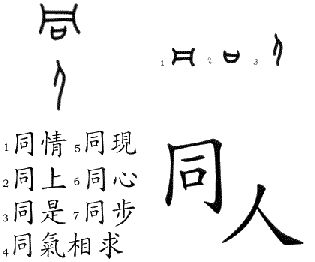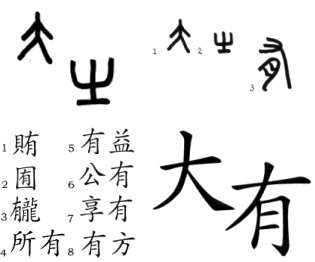Hu Gua
Qian Gua
Jiao Gua
Pang Tong Gua
Nuclear 44
Inverse 14
Reverse 14
Complement 7
Hexagram 13 and 14 Being one of all - being all of one
13 TONG REN, mankind
Ban Xiang Hu Gua Qian Gua Jiao Gua Pang Tong Gua |
Trigrams fire heaven Nuclear 44 Inverse 14 Reverse 14 Complement 7 |

Picture
at top: TONG2 REN2, the ancient characters and their
parts.
TONG2 REN2: Tong is composed of a molding box (1) with four carrying
bars, and mouth or opening kou3, or maybe object pin3 (2): same, alike (same castings: Wang Hongyuan p.106). Or maybe opening +
cover, 'fit together' (Karlgren).
TONG2 all, similar, equal, identical, resemblance, together,
communion, common, to share, to agree, the same as, identical, and, with, to
be associates, to conspire, to act in concord, flow together (rivers), to
uniformize measures, a domain of 100 square li, gathering and audience of
feudatory lords every 12 years, the female musical tones,
on oracle bones: to perform the Tong sacrifice. Ren2 (3) is man
or
people.
Tong ren as modern word: colleagues, person of same belief/conviction.
The characters at left: words or compounds with TONG2 or REN2
1
(same emotion) sympathize with
2 (same above) ditto; idem
3 (same to-be) both/all are
4 (same appear) co-occurrence
5 (same heart) concentric, of one heart, be of one heart
6 (same step) synchronism
7 (same atmosphere mutual seek) birds of a feather flock together (Qi,
atmosphere or vapor, is vital energy)
Some other interesting words with tong:
(same one nature) identity,
(same road, tao) same thought/principle, fellow party/group/etc.; member, go
the same way.
Same, similar, all. Similarity makes it possible to classify and to
recognize kinship. A common root connects what may look very different in
many other ways. It is the condition for mutual recognition.
Tong ren means something like 'similar people'. In Dutch there is a word which means both 'similar' and 'right'. The one of "you are right". In Dutch you say "you have gelijk", it is not something you are, it is something you have.
Tong is like this 'gelijk', similar, like 'them', one of them, the group, the class, the species, the clique. Thinking like them, behaving like them. 'Being right' has a lot to do with others agreeing with you. More others, more right.
Hexagram 13 is about both sides, being similar, but also about what happens if you are not. You can agree with 'them', feeling what they feel or agreeing with their point of view - or think like the masses without any personal contribution. Or you can be an individual among peers, thinking according to your own individual mind, and adding that to the group. And finally you can think according to your own mind but in disagreement with the group. Many different facets. Every time different, according to the person, the moment, the situation. And in between all those are gliding scales, more of this, less of that.
The noble one classifies the clans and reads the trails of creatures (or
according to Wilhelm: Thus the superior man organizes the clans. And makes
distinctions between things).
 "Read the trails": the
character biàn means distinguish, differentiate. It is composed of three parts:
2 criminals and a knife. The original character did not have the knife, and the
criminals looked quite different then... It has the same meaning as another bian,
which looks very similar, but is obsolete now, "Picture of an animal's track" --Karlgren.
"The steps of a wild beast... The examination of the trail indicating the kind
of animal, hence the extended meaning, to discriminate, to part, to sort out.
The excreta giving the same indication, biàn means dung in fen. –Wieger.
"Read the trails": the
character biàn means distinguish, differentiate. It is composed of three parts:
2 criminals and a knife. The original character did not have the knife, and the
criminals looked quite different then... It has the same meaning as another bian,
which looks very similar, but is obsolete now, "Picture of an animal's track" --Karlgren.
"The steps of a wild beast... The examination of the trail indicating the kind
of animal, hence the extended meaning, to discriminate, to part, to sort out.
The excreta giving the same indication, biàn means dung in fen. –Wieger.
The junzi reads the trails of creatures, he sees how much of an individual they are, or how much they fit in their class. How similar the trails of mammals are but how different the trail of a fox is from that of a bear. He sees when it is good to agree and when to differ. When morals are good and when suffocating. Which rules make it possible to live together in peace and which ones kill creativity.
Hexagram 13 is about the ‘tracks’ of humanity, about collective traits, basic to all of humanity. They are the reason one can recognize one’s fellow human being. The reason why it is at all possible to live together, to bear and to love and to understand each other.
To join with your environment .. but also to recognize how you are and are not defining it - and where it is defining you and where not. You are part of humanity and humanity is part of you.
14 DA YOU, great assets
|
|
Ban Xiang Hu Gua Qian Gua Jiao Gua Pang Tong Gua |
Trigrams heaven fire Nuclear 43 Inverse 13 Reverse 13 Complement 8 |

Picture at
top:
DA4,
the ancient character and its parts.
DA4. The upper character is a grown up man: big or great. The lower
one is CHI4, a hand: to have, to be, there is, to offer, sacrifice,
and, also, name of a place. Later YOU3 was used, and a piece of meat,
ROU4, was added (3), to emphasize possessing. According to others it
is YUE4, the moon, which resembles 'meat' very much, but the little
diagonal lines are straight in the moon, and in meat they are not.
In former times you3 also meant a good harvest, and da-you 'best
year' or 'best harvest'. According to Wieger the oldest meaning of you (3) was
eclipse or phase of the moon, but the oldest form of you (2) does not have the
moon (or meat).
DÀ: great, big, tall, large, much, very, extremely, eldest, senior, an
adult, to make large.
YOU3. To possess, to have, to exist, there is, to be rich, to
acquire, to
get, again.
The
characters at left: words or compounds with DA4
1
(money-have) bribe
3 (have-surround) ancient walled garden
5 (have-dragon) have both; lead along; ride a horse
7 (place/office have) own, possess, all
2 (have increase) profitable; beneficial; useful
4 (public have) publicly-owned; public
6 (sacrifice have) enjoy (right/etc.)
8 (have direction) be on right course
This character was also used for gifts from heaven, blessings. Possessing
extends also to talents, features.
Hexagram 13 was about what you have in common with all other humans, 14
about what makes you stand out among them. Primus inter pares.